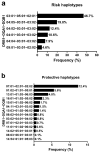Association between HLA Class II Alleles/Haplotypes and Genomic Ancestry in Brazilian Patients with Type 1 Diabetes: A Nationwide Exploratory Study
- PMID: 37239351
- PMCID: PMC10218425
- DOI: 10.3390/genes14050991
Association between HLA Class II Alleles/Haplotypes and Genomic Ancestry in Brazilian Patients with Type 1 Diabetes: A Nationwide Exploratory Study
Abstract
We aimed to identify HLA-DRB1, -DQA1, and -DQB1 alleles/haplotypes associated with European, African, or Native American genomic ancestry (GA) in admixed Brazilian patients with type 1 diabetes (T1D). This exploratory nationwide study enrolled 1599 participants. GA percentage was inferred using a panel of 46 ancestry informative marker-insertion/deletion. Receiver operating characteristic curve analysis (ROC) was applied to identify HLA class II alleles related to European, African, or Native American GA, and showed significant (p < 0.05) accuracy for identifying HLA risk alleles related to European GA: for DRB1*03:01, the area under the curve was (AUC) 0.533; for DRB1*04:01 AUC = 0.558, for DRB1*04:02 AUC = 0.545. A better accuracy for identifying African GA was observed for the risk allele DRB1*09:01AUC = 0.679 and for the protective alleles DRB1*03:02 AUC = 0.649, DRB1*11:02 AUC = 0.636, and DRB1*15:03 AUC = 0.690. Higher percentage of European GA was observed in patients with risk haplotypes (p < 0.05). African GA percentage was higher in patients with protective haplotypes (p < 0.05). Risk alleles and haplotypes were related to European GA and protective alleles/haplotypes to African GA. Future studies with other ancestry markers are warranted to fill the gap in knowledge regarding the genetic origin of T1D in highly admixed populations such as that found in Brazil.
Keywords: HLA; admixed; ethnicity; genomic ancestry; human leukocyte antigen; type 1 diabetes.
Conflict of interest statement
The authors declare no conflict of interest.
Figures





References
-
- Ogle G.D., James S., Dabelea D., Pihoker C., Svennson J., Maniam J., Klatman E.L., Patterson C.C. Global estimates of incidence of type 1 diabetes in children and adolescents: Results from the International Diabetes Federation Atlas, 10th edition. Diabetes Res. Clin. Pract. 2022;183:109083. doi: 10.1016/j.diabres.2021.109083. - DOI - PubMed
-
- Negrato C.A., Lauris J.R.P., Saggioro I.B., Corradini M.C.M., Borges P.R., Crês M.C., Junior A.L., Guedes M.F.S., Gomes M.B. Increasing incidence of type 1 diabetes between 1986 and 2015 in Bauru, Brazil. Diabetes Res. Clin. Pract. 2017;127:198–204. doi: 10.1016/j.diabres.2017.03.014. - DOI - PubMed
Publication types
MeSH terms
LinkOut - more resources
Full Text Sources
Medical
Research Materials
Miscellaneous

